As usual, I went up to Willsboro over the MLK holiday long weekend, leaving Friday 18 January and returning Monday 21 January. This was the first time I’ve been up since we moved out of Green Bay, so going up there definitely brought up mixed feelings. Originally, both Andrew and I planned to go up, and our cousin Peter had generously offered us rooms at his house Red Farm. Andrew, however, could not break free from some other commitment, so I went up solo and stayed with our friend John Rayburn at his newly renovated/winterized house Birchcliff out on Willsboro Point—John has cats, and even though they were not there for this trip, Andrew’s allergies would have made staying there difficult for him if he’d come along.
John and I had a great weekend, very relaxed and comfortable with our usual mix of music, cigars and hockey. We put in the obligatory appearance at the North End Tavern, and I helped John entertain friends by cooking diner Saturday evening (Garlic & Oil Pasta).
While up there, I drove over to River Road to check out Green Bay. I knew that Jan Fritze, the cousin who took over the house, had extensive renovation plans (long overdue!) and that work was due to begin this past fall, but I had only second-hand information on what those plans were and what timeline was involved. I’d heard that the kitchen wing was slated for a complete makeover, changing it into a more open-plan modern family kitchen design, and that the upstairs was due for major reconfiguration to create more usable space up there. I’d also heard that plans were in place to make bathrooms in the bedroom wing directly accessible from the bedrooms, but I had no information on what that might entail.
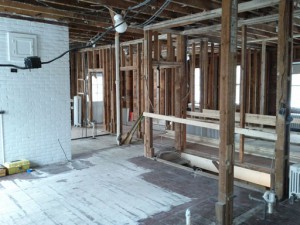 In fact, there’s much more renovation work going on than I thought. The first space I entered was the kitchen wing, and as you can see from these pictures the entire interior has been deconstructed down to the studs. This first picture shows the view from what was the doorway to the dining room—the white chimney is where the stove stood, with the kitchen parlor behind it. To the right of the chimney you can see the stairs leading down the the basement, in front of which you can make out an “L” shaped strip of the old maroon linoleum kitchen flooring. In the foreground are some studs that mark where the wall between the kitchen and the pantry stood.
In fact, there’s much more renovation work going on than I thought. The first space I entered was the kitchen wing, and as you can see from these pictures the entire interior has been deconstructed down to the studs. This first picture shows the view from what was the doorway to the dining room—the white chimney is where the stove stood, with the kitchen parlor behind it. To the right of the chimney you can see the stairs leading down the the basement, in front of which you can make out an “L” shaped strip of the old maroon linoleum kitchen flooring. In the foreground are some studs that mark where the wall between the kitchen and the pantry stood.
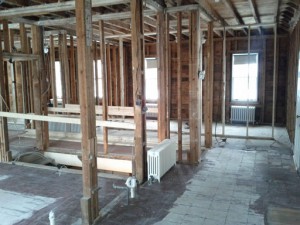 This next picture shows a view from the same vantage point, but turned towards the right to look down what had been the pantry hallway. At the end of the hall you can see one of the (I think) temporary stud walls (the newer, brighter wood) which I suspect were added to give structural support before removing the old stud-walls and opening up the space. The temporary wall is located inside what had been the gun room; the little maids room was centered on the second window from the right.
This next picture shows a view from the same vantage point, but turned towards the right to look down what had been the pantry hallway. At the end of the hall you can see one of the (I think) temporary stud walls (the newer, brighter wood) which I suspect were added to give structural support before removing the old stud-walls and opening up the space. The temporary wall is located inside what had been the gun room; the little maids room was centered on the second window from the right.
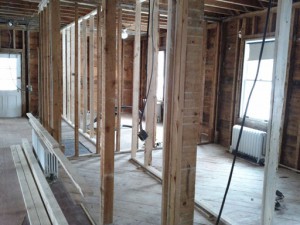 This last look at the kitchen wing is taken standing in front of the door that leads from the old pantry out to the terrace, looking down the old hallway towards the back door. Some of the temporary walls are more clearly visible, continuing down through the maids room and the “put” room.
This last look at the kitchen wing is taken standing in front of the door that leads from the old pantry out to the terrace, looking down the old hallway towards the back door. Some of the temporary walls are more clearly visible, continuing down through the maids room and the “put” room.
All of the deconstruction in the kitchen wing came as no surprise given what I knew of the planned renovations, but I was really bemused when I stepped into the dining room. It also was stripped down to the substructure, which on reflection would make sense if infrastructure improvements like new wiring, plumbing, heating/cooling and so forth are also being done. What was intriguing, however, was what I saw under the supports for plaster lathe work.
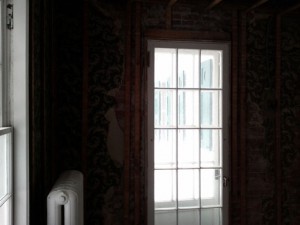 This first picture is a bit dim due to the strong light coming in from outside, but you can see that the lathe supports were added on top of pre-existing wallpapered plaster, which itself had been placed directly on the interior of the house’s brick walls. My guess is that the old plaster and wallpaper were there before the wings were added in the early part of the 20th century.
This first picture is a bit dim due to the strong light coming in from outside, but you can see that the lathe supports were added on top of pre-existing wallpapered plaster, which itself had been placed directly on the interior of the house’s brick walls. My guess is that the old plaster and wallpaper were there before the wings were added in the early part of the 20th century.
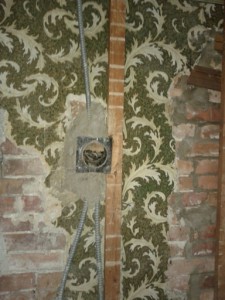 This next picture is a close-up of the old wallpaper. You can clearly see how lathe supports for later plastering were added on top of it, and an even later addition of an electrical fixture. I suspect this latter item dates from when my Grandfather purchased the house and re-did much of the wiring.
This next picture is a close-up of the old wallpaper. You can clearly see how lathe supports for later plastering were added on top of it, and an even later addition of an electrical fixture. I suspect this latter item dates from when my Grandfather purchased the house and re-did much of the wiring.
I was also fascinated by the interior bricks exposed. The central brick section of the house is the oldest part, possibly dating back as early as the 1840’s, with the wings being added in the 19-teens or 1920’s. Obviously there were a lot of changes made to the original brick structure when the wings were added. 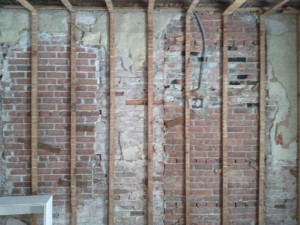 This next picture, of the south wall of the dining room (about where the sideboard stood), shows evidence of what may have been an old door or window that was bricked up when the wings were added. I also suspect that a hearth and chimney stood along that wall, although my best guess, based on structure visible in the basement, is that they were located more-or-less where the doorway to the pantry is located now.
This next picture, of the south wall of the dining room (about where the sideboard stood), shows evidence of what may have been an old door or window that was bricked up when the wings were added. I also suspect that a hearth and chimney stood along that wall, although my best guess, based on structure visible in the basement, is that they were located more-or-less where the doorway to the pantry is located now.
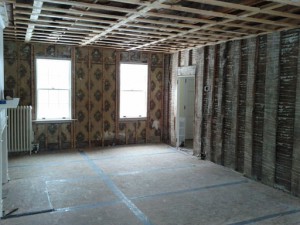 Like the dining room, the living room has also been stripped down to the lathe supports, with evidence of older plaster and wallpaper behind them. The central hallway hasn’t been touched (you can see the back of the hallway’s plaster lathes), but I’m intrigued by the wide boards used in the wall between the living room and the hallway, visible in the right of this picture taken from the doorway to the bedroom wing.
Like the dining room, the living room has also been stripped down to the lathe supports, with evidence of older plaster and wallpaper behind them. The central hallway hasn’t been touched (you can see the back of the hallway’s plaster lathes), but I’m intrigued by the wide boards used in the wall between the living room and the hallway, visible in the right of this picture taken from the doorway to the bedroom wing.
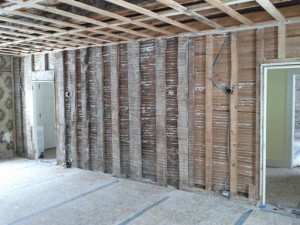 At one time, the living room must have been two separate rooms. In this picture, you can clearly see a change in the structure three-quarters of the way along the wall between the living room and the hallway—that structure also looks newer, so I wonder if the hallway originally did not pass all the way from the front to the rear of the house. In addition to the structure change, the pattern of the old wallpaper also changes in the rear quarter of the room.
At one time, the living room must have been two separate rooms. In this picture, you can clearly see a change in the structure three-quarters of the way along the wall between the living room and the hallway—that structure also looks newer, so I wonder if the hallway originally did not pass all the way from the front to the rear of the house. In addition to the structure change, the pattern of the old wallpaper also changes in the rear quarter of the room.
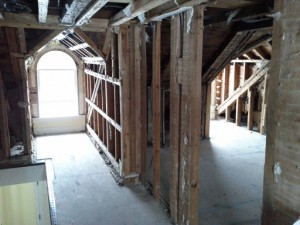 Upstairs, I was not at all surprised to see a more complete deconstruction given what I’d heard about Jan’s plan to expand the space up there. This view, taken from the head of the stairs, shows the upstairs hallway and hallway dormer, the door opening for the upstairs bedroom, and part of the bedroom beyond. What did surprise me was looking at the upstairs bathroom.
Upstairs, I was not at all surprised to see a more complete deconstruction given what I’d heard about Jan’s plan to expand the space up there. This view, taken from the head of the stairs, shows the upstairs hallway and hallway dormer, the door opening for the upstairs bedroom, and part of the bedroom beyond. What did surprise me was looking at the upstairs bathroom. 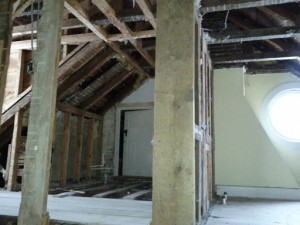 I knew that the floor of the bathroom had been raised in order to make room for plumbing underneath. You can see this elevation difference in the picture at right, taken while standing on the stairs and looking towards the bathroom and the little storage room. In the process of creating the raised floor, however, the builders had to also move the wall behind where the bath-tub used to be further out to leave enough room under the slope of the roof.
I knew that the floor of the bathroom had been raised in order to make room for plumbing underneath. You can see this elevation difference in the picture at right, taken while standing on the stairs and looking towards the bathroom and the little storage room. In the process of creating the raised floor, however, the builders had to also move the wall behind where the bath-tub used to be further out to leave enough room under the slope of the roof. 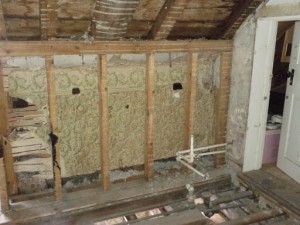 Behind the newer wall you can see remnants of the old wall, also with wallpaper over plaster. The picture at left gives a clearer view of the old wall, but you have to look carefully to realize it’s located a good 6 inches or more behind the visible studs. I considered exploring the attic to see if the ceder closet was still intact, but as you can see I was not at all sanguine about footing—you’re looking down into the living room!
Behind the newer wall you can see remnants of the old wall, also with wallpaper over plaster. The picture at left gives a clearer view of the old wall, but you have to look carefully to realize it’s located a good 6 inches or more behind the visible studs. I considered exploring the attic to see if the ceder closet was still intact, but as you can see I was not at all sanguine about footing—you’re looking down into the living room!
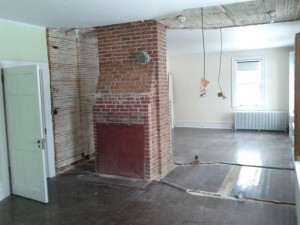 The only solid information I had concerning plans for the bedroom wing was that some form of access was planned between the guest bedroom and the guest bathroom located next to it. I suspect that an entrance will be cut through the old linen closet into the bedroom, but aside from a gutted linen closet I didn’t see any evidence of construction/deconstruction in the bedroom itself.
The only solid information I had concerning plans for the bedroom wing was that some form of access was planned between the guest bedroom and the guest bathroom located next to it. I suspect that an entrance will be cut through the old linen closet into the bedroom, but aside from a gutted linen closet I didn’t see any evidence of construction/deconstruction in the bedroom itself. 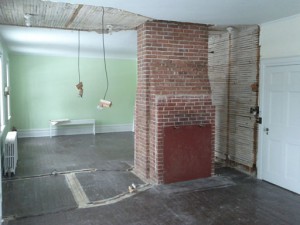 Across the hall, however I was really surprised to see the wall removed between “Molly’s room” and the dressing room. Essentially, the closets for both rooms have been removed, and I wonder if Jan plans to put a bathroom in there to give those rooms direct access to one.
Across the hall, however I was really surprised to see the wall removed between “Molly’s room” and the dressing room. Essentially, the closets for both rooms have been removed, and I wonder if Jan plans to put a bathroom in there to give those rooms direct access to one.
My next trip to Willsboro will probably be over Memorial Day weekend for the Poko Patch Sprint. I’m eager to see what’s been done at Green Bay in the meantime.

